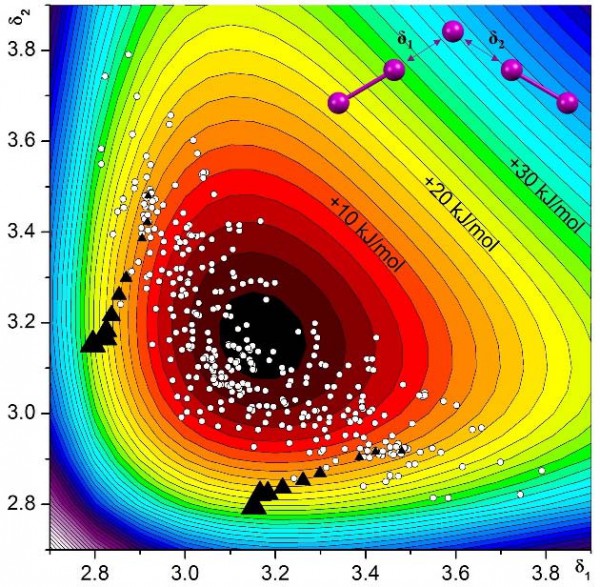Study shows pressure induces unusually high electrical conductivity in polyiodide
by Carey Sargent, EPFL, NCCR MARVEL
Polyiodides exhibit useful electrochemical properties such as charge-carrier transportation, high electrolyte energy density, high redox reaction reversibility and a wide range of electrical conductivity, all depending on the forces exerted by the organic counter ions—chemical pressure. For this reason, polyiodides have been used in technical applications in electronic and electrochemical devices such as flow batteries, fuel cells, dye sensitized solar cells and optical devices.
In this study, researchers led by Prof. Piero Macchi, experimental group leader in MARVEL’s Design and Discovery Project 4 and head of the laboratory of chemical crystallography at the Department of Chemistry and Biochemistry of the University of Bern, and Dr. Nicola Casati, group leader of the Materials Science group at PSI, used powder and single-crystal X-ray diffraction, electrical conductivity, and first principle calculations to investigate the response of one polyiodide, tetraethylammonium di-iodine triiodide (TEAI), to compression achieved by mechanical pressure.

The electronic energy of I5- calculated in vacuo, as a function of δ1 and
δ2. The colour indicates the destabilization from the symmetric I5-. The white
circles represent entries in the Cambridge Structural Database containing I5-.
The black triangles represent TEAI at different pressures (the triangle size is
proportional to the pressure).
Compared with the chemical pressure, external mechanical pressure affects the crystal inter- and intramolecular landscape more substantially—a huge lattice strain may induce phase transformations and even chemical reactions. Using diamond anvil cells, it is possible to achieve pressure on the order of tens of gigapascals, a pressure that significantly changes the Gibbs energy, increasing internal energy. Similarly large energy changes are not possible through temperature alteration in solids.
Though complementary I3- and I2 units are clearly separated and interact mainly electrostatically at ambient pressure, the researchers found that compression stimulates their approach—theoretical calculations show that the covalent contribution increases when the material is compressed. Ultimately, this leads to the formation of CT chains, and drastically increased conductivity.
These features make TEAI a tunable pressure-sensitive electric switch. Structural studies at high pressure can rationalize the synthesis and search for future organic and hybrid semiconductors based on PI. The study results indicate that solid PI may be used as solid electrolytes in dye-sensitized solar cells, eliminating the need for organic-based gelators and ionic liquids in general.
The paper was funded in part by NCCR MARVEL.
Reference: Pressure-induced Polymerization and Electrical Conductivity
of a Polyiodide
Tomasz Poręba, Michelle Ernst, Dominik Zimmer, Piero Macchi* and Nicola Casati*
Low-volume newsletters, targeted to the scientific and industrial communities.
Subscribe to our newsletter